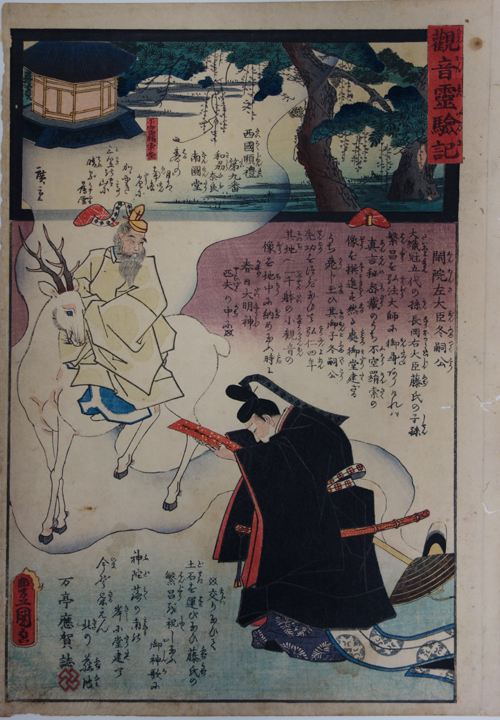Sacred Space and Japanese Art at the Spencer Museum of Art
Entry by Yen-Yi Chan
This print illustrates the miraculous origin story of the Nanendō, the South Octagonal Hall at Kōfukuji temple. Depicted at the top left corner, the hall is cloaked in a mysterious air from which the deity Kasuga Daimyōjin from nearby Kasuga Shrine descends riding on a deer. Fujiwara no Fuyutsugu (775–826), who built the Nanendō, kneels in front of the deity. The text written beside the figures tells that during the construction of the Nanendō’s foundation, Fuyutsugu buried 1,000 Kannon sculptures in the earth, at which point the Kasuga Daimyōjin appeared in a disguise as a commoner who helped construct the Nanendō. The deity then spoke, “A hall was built on the southern shore of Fudaraku; the wisteria waves of the north flourish even now.” The verse explains the sacred and auspicious character of the Nanendō by identifying it as Mt. Fudaraku, the paradise of Kannon, who is the Bodhisattva of Compassion in the southern seas.
In fact, the hall, located in the southwest corner of Kōfukuji, enshrines an icon of Fukūkenjaku Kannon (Avalokiteśvara with the Unfailing Rope). The wisteria (fuji) in the verse refers to the northern branch of the Fujiwara family because it is one of the characters from the family’s name. Kasuga Daimyōjin’s blessing to the family portends that they will flourish for generations after the dedication of the hall.

Nanendō (Number 9) from the series Saikoku sanjūsansho, Kannon reigenki (Thirty-three temple pilgrimage of the western country, chronicle of Kannon miracles)
Japan, Utagawa Kunisada (1786–1864) and Utagawa Hiroshige II (1826–1869)
1858–1859, Edo period (1615–1868)
Color woodcut
36.4 x 25.5 cm
Private collection
